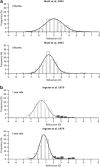Emmetropisation and the aetiology of refractive errors
- PMID: 24406411
- PMCID: PMC3930278
- DOI: 10.1038/eye.2013.276
Emmetropisation and the aetiology of refractive errors
Abstract
The distribution of human refractive errors displays features that are not commonly seen in other biological variables. Compared with the more typical Gaussian distribution, adult refraction within a population typically has a negative skew and increased kurtosis (ie is leptokurtotic). This distribution arises from two apparently conflicting tendencies, first, the existence of a mechanism to control eye growth during infancy so as to bring refraction towards emmetropia/low hyperopia (ie emmetropisation) and second, the tendency of many human populations to develop myopia during later childhood and into adulthood. The distribution of refraction therefore changes significantly with age. Analysis of the processes involved in shaping refractive development allows for the creation of a life course model of refractive development. Monte Carlo simulations based on such a model can recreate the variation of refractive distributions seen from birth to adulthood and the impact of increasing myopia prevalence on refractive error distributions in Asia.
Figures









References
-
- Limpert E, Stahel WA, Abbt M. Log-normal distributions across the sciences: keys and clues. Bioscience. 2001;51:341–352.
-
- Sokal RR, Rohlf FJ.Biometry: The Principles and Practice of Statistics in Biological Research3rd ednW.H. Freeman: New York; 1995
-
- Stenstrom S. Investigation of the variation and the correlation of the optical elements of human eyes. Am J Optom Arch Am Acad Optom. 1948;25:496–504. - PubMed
-
- Steiger A. Die Entstehung der sphärischen Refraktionen des menschlichen Auges. Karger: Berlin; 1913.
Publication types
MeSH terms
LinkOut - more resources
Full Text Sources
Other Literature Sources

